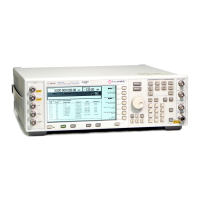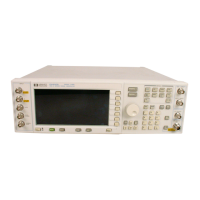11
www.agilent.com/find/esg
Figure 8. Example multi packet sequence setup.
The data type selected in the data pattern pull-down menu is spread over the payload
portion of the packet sequence, Figure 9. The length of the data stream can be defined
by either setting the number of bits in the length field or the number of times the pattern
is repeated in repetitions field. When either of these fields is modified, the other is
automatically updated. The number of packets required to accommodate the length
and repetition field setting is automatically updated in the Payload Summary section of
the menu.
Figure 9. Data Pattern pull-down menu.
The payload of each packet in the sequence is filled to capacity with the selected data
pattern if possible. When the length of the data pattern is selected such that it is not
divisible by an integral number of packet payloads, a packet with a partial payload is
generated to accommodate the remaining portion of the data pattern. This packet is
then appended to the sequence of full packets.
Note: The payload portion of a Bluetooth packet must be filled with an integral number of data bytes
(1 byte = 8 bits). If the length of the data pattern is not evenly divisible by eight bits, then zeros are appended
to the selected data pattern until this criteria is met.
Two packet sequence presets, continuous PN9 and continuous PN15, are provided in
the data pattern pull-down menu when multi packet is selected, Figure 9. These presets
are intended to simplify the setup process when configuring a packet sequence with
continuous PN data distributed over the payload portion of each packet payload. When
continuous PN9 or PN15 is selected in the Data Pattern pull-down menu, the software
automatically configures the Length and Repetitions fields, Figure 10. The number of
packets required to accommodate the selected continuous PN pattern is also
automatically determined and updated in the Payload Summary section.
Creating Signals

